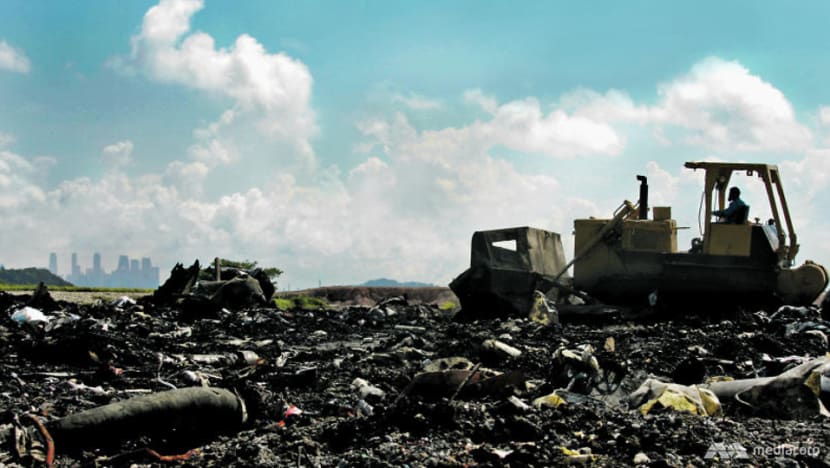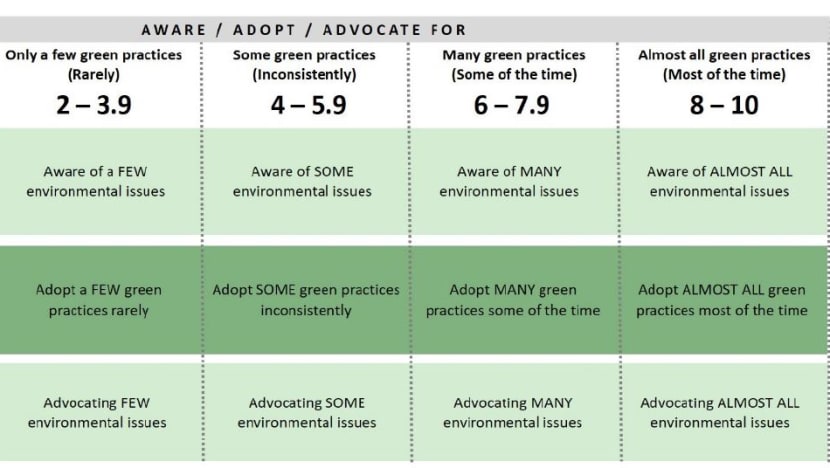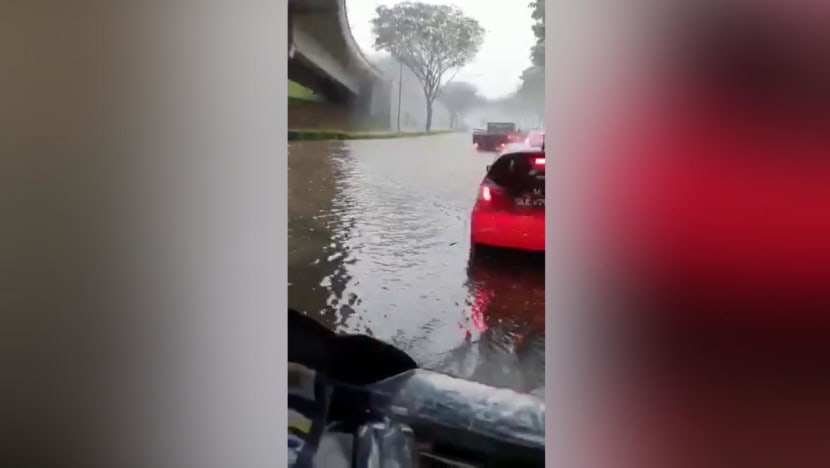How can Singapore bridge the gap between climate change awareness and sustainable actions?
While many people in Singapore are aware of environmental issues, fewer adopt green practices. On Earth Day, CNA examines the reasons for that gap and whether it can be closed.

File photo of Pulau Semakau landfill.
SINGAPORE: Madam Tan Siew Moi limits her family’s use of air-conditioning to less than an hour a day and constantly reminds her children to keep showers short.
But like most in her circle of friends, Mdm Tan drives a medium-sized Nissan car that uses petrol. While she is aware of the pollution caused by petrol cars, she does not intend to switch to an electric vehicle.
Like Mdm Tan, many Singapore residents are generally aware of climate change and more sustainable alternatives to their day-to-day goods.
National awareness campaigns and revamped policies, such as raising the carbon tax and the Singapore Green Plan, have brought the issue of climate change to the fore.
But in August last year, an inaugural Climate Index research found that while Singapore residents had a high awareness of environmental issues across the four lifestyle themes of transport, home, food and goods, this was not reflected in terms of their adoption of green practices.
The survey, which gathered responses from 2,000 Singapore residents, was launched by OCBC Bank in partnership with Eco-Business, an independent media and business intelligence company.
On a 10-point scale, the respondents scored an average of 8.3 in awareness, but only 6.5 in adoption and 5.6 in advocacy.

For example, the survey showed that while 81 per cent of respondents are aware of the time taken for a plastic bag to degrade, only 22 per cent of people are shopping with reusable bags every time.
Most of the respondents cited cost and inconvenience as the top two reasons that stopped them from adopting green practices, while 24 per cent said either the status quo was sufficient or that they did not care about the issue.
ABOUT THE COST
There is a long stream of research that proves the disconnect between attitudes and intentions versus behaviours, explained Professor Sharon Ng, head of the marketing division at Nanyang Business School.
She has authored academic papers on the impact of globalisation on sustainable consumption and the role of personal responsibility when it comes to environmentally friendly products.
Prof Ng said she was not surprised by the survey's findings. She added: “The minute you put in trade-offs, financial resources or … time ... The minute this comes to the computation, we no longer hold on to the strong belief that yes, you need to do it for the good of the world.
"Doing it for the good of the world doesn't cost you anything. (When) there is some cost, the computation changes.
“And that’s what I mean. This attitude and behaviour don’t necessarily correlate very strongly.”
When there is a trade-off to be made, cost is a big factor when people make decisions, said Prof Ng. Referencing one of her research publications, she shared how there was a gap between consumers’ desire to support sustainability efforts and their willingness to pay for environmentally friendly products.
“We did a study where we actually asked people to indicate how much they will support sustainability behaviour. Usually you get quite a high percentage, 70 per cent, 80 per cent, on average. Everybody thinks they should support sustainability behaviour,” she said.
But when the respondents were given products to choose from, researchers saw a drop in the percentage of people who were willing to buy a green product that was marked up by 5 per cent to 10 per cent.
Is it about buying “greener” or just buying less? We discuss how sustainable consumption should look like with Marketing Professor Sharon Ng on The Climate Conversations:
There is also the issue of time and effort. The survey identified cost and inconvenience as the top two reasons for not adopting green practices.
The survey’s respondents exhibited a dissonance between intent and action. While 95 per cent of drivers who responded were aware that travelling by car generates 12 times more CO2 emissions than travelling by train, about 78 per cent of them still drive for more than 30 minutes daily.
The survey also showed that while about 90 per cent of respondents were aware of the carbon impact of different fuel categories, 74 per cent of them still owned diesel or petrol vehicles, which have a much higher carbon footprint than hybrid or electric options.
People also value their time over sustainability efforts, and money over recycling, said Prof Ng.
Mdm Tan related strongly to these two factors.
“On areas that involve cost-savings, I would say that I have good (eco-friendly) habits, like saving electricity and water … But I don’t think I can adopt (further) practices as it will require too much change to my current lifestyle,” she said.
GOING BEYOND AWARENESS
Connecting a person’s day-to-day encounters and climate change may be key, said Mr Ho Xiang Tian, the co-founder of environmental group LepakInSG.
In the past two years, new work modes amid the COVID-19 pandemic saw many employees working from home, eliminating their daily commute. The commute typically exposes them to the elements, allowing them to take notice of climate changes.
“This February has been very wet, which is quite strange. I don’t think people connect this to climate change,” said Mr Ho.
The Met Service found 2021 to be Singapore’s second wettest year since 1980. One consequence of climate change is increased rainfall, which can lead to floods like those in Sydney recently that swamped whole cities. But in Singapore, most floods are flash floods that subside quickly with little danger.

Mr Ho gave another example of how Singapore deals with dry spells, compared to other countries.
“In previous years, when we had dry spells in February, people also don’t really connect that to climate change. They just think ‘oh the weather is strange’,” said Mr Ho.
While parts of Malaysia had to do water rationing during a dry spell in 2014, Singapore did not have to. Technology investments, such as NEWater and desalinated water, saw Singapore through some of its driest periods in early 2014.
“People don’t connect this dry spell with ‘I need to save water'. It's just, ‘oh got dry spell, I don’t know, the grass outside looks like it’s going to die’. But that’s it,” he said.
“I would say, people have no reason to change their lifestyles and habits. Because of their awareness of climate change – to them, it’s something that’s happening somewhere else, it’s not happening to me now,” he added.
Ms Sarah Lin, a climate action activist, said her “awakening” was sparked by a photograph of cutlery, plates and cups in large green dustbins at the back of hawker centres.
“It was filled to the brim with disposable plates, foam plates, cups, and everything else. It just hit me … this is probably like half a day's worth,” she said.
“Imagine it accumulating to become a day's worth, and a month’s worth … that really shocked me.”
Connecting that image to the waste she saw every day working in the events industry made her recognise that her actions have an environmental impact.
Since that realisation, Ms Lin has transitioned quickly from awareness to adoption and then to advocacy. She has been volunteering with LepakInSG to manage and organise events around environmental action and awareness.
NO TIME TO WAIT FOR THE NEXT GENERATION
“Until people are willing to make the trade-off, any sustainability initiative the authorities come up with will be met with limited success. As a society, we cannot rely on punishment as the only solution to get people to be more sustainable,” said Prof Ng.
“A successful sustainability culture needs to be cultivated and this requires mindset changes and a deep belief that such trade-offs are worth it.”
Education might be the key, particularly for children in their formative years. Mr Ho started his environmental journey from a young age.
“When I was in kindergarten, I got this set of children's books from NEA (National Environment Agency). It’s about this character called Captain Green. He and his friends go around, learning about the three Rs (reduce, reuse, recycle),” Mr Ho said.
“And they basically learn, if you litter everywhere, and you don’t recycle, then the whole of Singapore will be filled with trash. That shocked my five, six-year-old self.”
He started asking friends and family to be more environmentally friendly.

“Cultivate sustainability practices from young. Do not make it an option but make it something that is ingrained in our regular behaviour – equivalent to brushing our teeth or washing our things every day. Make it a habit,” said Prof Ng.
Mr Ho agreed. “When (you) are six years old, you don’t care about cost and inconvenience, right? You just think this is something we should do,” he said.
This mindset change is “not that far” away, Prof Ng said.
“Once we get more people involved, once the younger generations come out and become consumers, then we’re going to see more of these things happening,” she added.
“Right now, the Gen Zs are definitely way more sustainable in their thinking. But they are not the major consumers yet.”
Former United Nations Secretary-General Ban Ki-moon said in 2015 that this generation was the “first generation that can end poverty and the last that can end climate change”.
But more than half a decade later, climate activists and scientists are saying that current adaptations to climate change would not be enough to save our planet.
The Sixth Assessment Report from the Intergovernmental Panel on Climate Change (IPCC) said that unless excessive global warming is reined in by the mid-century, Southeast Asia will experience a range of worsening conditions and disasters.
These include heat waves, intense rain events, powerful tropical cyclones and coastal cities inundated by rising sea levels.
“We cannot wait 20 years for the next generation to learn. In the long term, yes, education is important,” said Mr Ho.
How can people make a difference now?
Measures, such as government support and extended producer responsibility, can help remove cost and inconvenience from consumers’ considerations when it comes to taking environmentally friendly actions, said Ms Lin.
"Being an active citizen, and actively voicing out your stand on these things, not only individual matters like ‘I want to bring a bag’, but also, ‘I want to see companies shifting away from plastic bags and charging for them’ for example,” she added.
“I think using that voice and actively engaging businesses, governments, your MPs are some of the ways that society can be more involved in sort of shifting that change.
“It is a long process, I would say, but it has also seen … more accelerated change in recent years.”
Those interviewed said that it is important to reframe sustainability conversations so as to make climate change more relatable.
Prof Ng said: “(Studies) have shown that if we highlight the impact of (climate change) on your community, it makes it a little bit more concrete.
“So you can visualise if this happened, this is what is going to happen to my life, or this is what is going to happen to my local community. That makes it a little bit more tangible.
“It is not this abstract ideal that we’re fighting for. It is a more tangible thing that I know is going to affect me.”
Agreeing, Mr Ho said that people need “more visual reminders of climate change”.
He suggested installing sensors at Housing Board blocks. While residents are waiting for lifts, these sensors tell them the current temperature and rainfall levels, as well as the historical temperature and rainfall trends. This way, residents can understand how these trends have changed.
“I feel that environmental issues are quite intersectional to social issues. Not everyone would be concerned about the environment – there are some people who are just in that camp,” said Ms Lin.
“It's about how we reach out to them in different aspects. So maybe it's connecting to social issues.
“For example, we see more and more homeless people being exposed to the extreme elements. We are quite sheltered, so we get to hide from the rain and the sun, and on the aircon, but they don't. So, I guess it's the way we frame things.”














